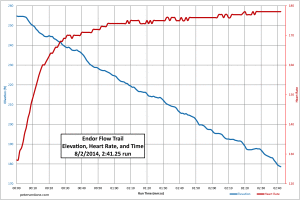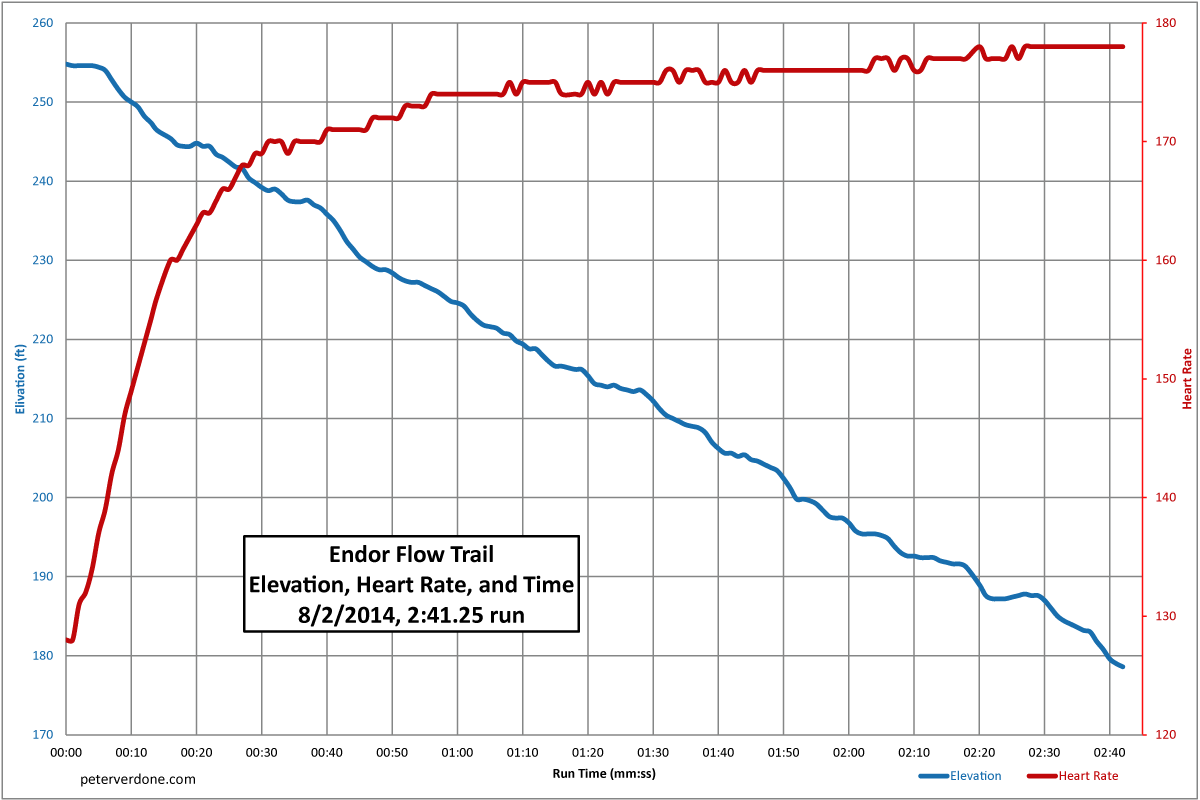Sometimes on the trail, when discussing with some folks on how to clean an uphill switchback or ride a section of trail fast, the old expression will come up that you need to “put in 100%”. It get’s said a lot. Still, I don’t think people really know what it means.
Here’s an example from the Tamarancho Endor Flow Trail. This was a quick run as I was chasing a lure, Dylan Renn. I gave him a few seconds start at the top and I had to hunt him down on course, catching him as we exited at the bottom. This is one of the most effective ways for me (personally) to go fast, chasing or getting chased. Time trials are hard. Later while hanging out at Gestalt, we discussed a bit on how to improve times and some coaching that could be done to get down into the 2:30s. I need to do a lot work on my technique as I waste a lot of energy on course and could pick up speed just by riding better. Physically, though, I’m fine with calling this a 100% effort.
Dylan and I talked about the graph I show above and below. Comparing my heart rate to altitude is something we can do on the trail. GPS doesn’t work on the trail and we manually time with bar mounted stopwatches, but altitude and heart rate are stored to the logger just fine. As 178 bpm is my physical limit before I go completely and devastatingly anaerobic, I’m really pushing into that territory for the vast majority of a run. I arrive at the bottom of each run with nothing left, gasping for air and about to fall over. The physical pain that starts within the first thirty seconds is excruciating. I’m fighting the urge to just stop but instead push harder for more speed. My technique could be a lot better but I’m physically giving my all. Get the two right and there is a personal record in there somewhere.
Many people running the flow trail will arrive at the bottom fully capable of conversation and in good spirits. That’s fine if the goal was a simple cruiser run. Other folks roll out much in the same way but frustrated that they didn’t keep up or are putting out slow times. They simply aren’t putting in the hard work on the trail. They forget that to go fast on a bike you have to make it go fast with effort. To make it go really fast, you need to put in 100 percent. …and take a few calculated risks.
The point that I’m talking about in this post is that we need to understand the meaning of ‘giving 100%’. Are you giving up before you start that turn? Are you pushing on your pedals and pulling on your arms as hard as you possibly can? Are you putting yourself at risk of crashing but pushing through with power regardless? Are you thinking and planning constantly?
One of the nice things about this example is that it is showing physical output on the bike, but going downhill…with only a few sparing pedal strokes during the run. Too many riders put the focus of their physical efforts into just the climbs then, essentially, lollygag down the back side. They ignore the gravity and speed side of the sport where riding skill actually starts becoming a factor. But it’s not just about riding skill in downhill or enduro. A rider needs to be able to ride fast and not make mistakes at just as high or higher of an output as the climber, often at the end of a long weekend of riding. Without practice getting to this state, it is very difficult to do well. Regular practice on average rides bringing the body to a frantic state will make it possible to do fairly well when the right time comes. Practice getting to 100%.
At the Endor Flow Trail at Camp Tamarancho, another situation comes up that is relevant to all this. Seat dropping. To ride Endor at any kind of speed or flair requires the seat to be set at the absolute lowest height. The saddle on my flow bike is right on top of the rear tire and that’s on a small 26″ wheel. Gravity riders of days gone by would always drop their saddle for descents that required it via a quick release or 5mm allen wrench. These days, there are adjustable seat posts that make this quick and easy (even while they really don’t drop the saddle enough for Endor). This is a boon for most folks who never really got it before. Still, many XC riders or dirt roadies will show up to the top of the trail on fixed posts and refuse to lower their saddles to ride. It must be some kind of badge of honor for them to suck at riding bikes because this is the flag they fly high. What it’s really saying is that they don’t ride challenging descents and that they’ve never learned how to move a saddle during a ride. These guys are bringing 20% to the trail. Worse, they are learning none of the skills that they, without a doubt, desperately need. Practice setting yourself up for 100%
I’ve told people to give one hundred percent at time and seen them immediately throw down a lousy 40% effort. Do you do this? Are you just a quitter? The first step is admitting you have a problem.
One of the nicest things about wearing a heart rate monitor is that it keeps you honest. I tend to always have one on. You know if you are actually working or not. If I look down and see 156 bpm on the meter, I know that I have to kick it up to the mid 160s just to know I’m doing a real effort ride. It also gives an alarm when you go too deep into the danger zone and need to back off. Handy. I really do recommend them for most riders that are interested in something more than just a social ride. They can’t make up for not putting in the time with technical skills or how much sleep or food you ate before going out but they will make you honest about your physical effort.
Putting in a high amount of effort takes practice. Even for a short amount of time, to fight the urge to give in, involves months of work. For longer efforts it’s pretty crazy what it takes. I’m, very honestly, a crappy cross country rider. I just can’t suffer the way you need to to keep up. I practice though. I push myself on rides to go fast an hard for sustained climbs. To keep my legs pushing for long periods of time. Admitting that you suck at something doesn’t mean that you don’t put the work into reducing that suck.


